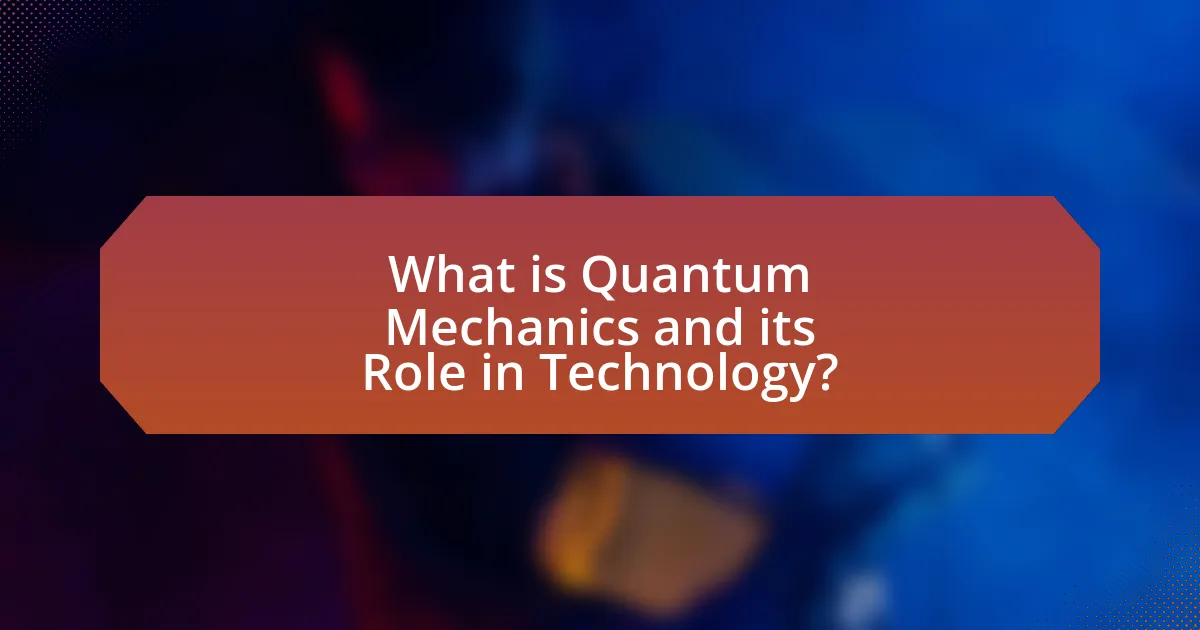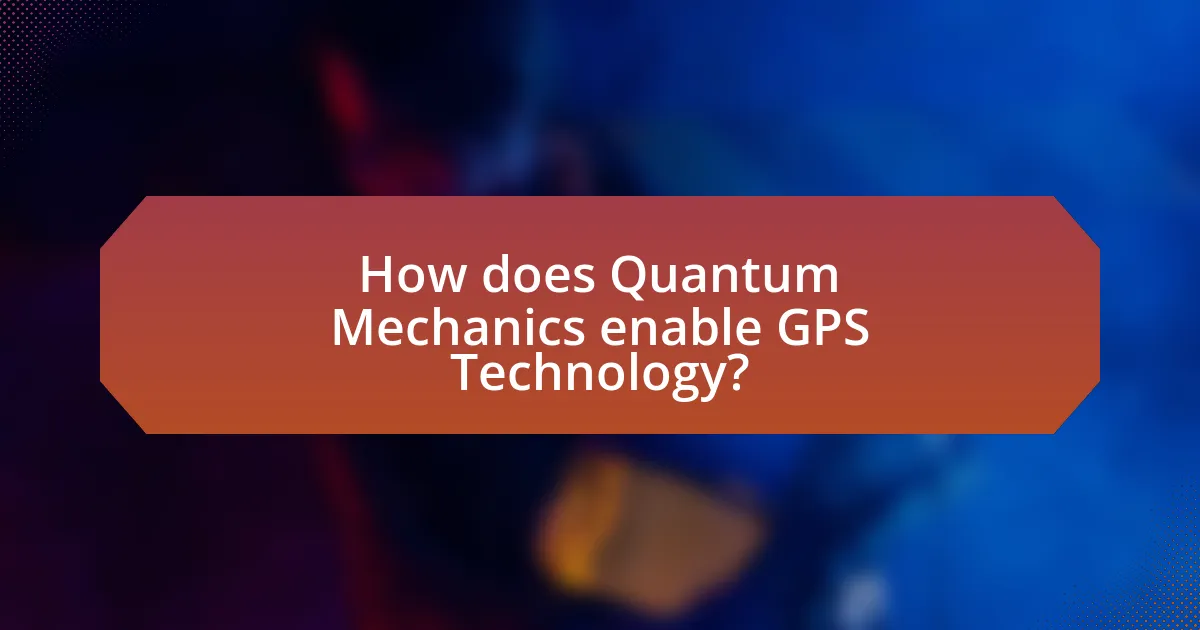Quantum mechanics is a fundamental branch of physics that examines the behavior of matter and energy at atomic and subatomic levels, playing a crucial role in modern technology. This article explores how quantum mechanics underpins essential innovations such as lasers, semiconductors, and GPS systems, highlighting its principles like wave-particle duality, uncertainty, superposition, and entanglement. It details the practical applications of these principles in everyday devices, emphasizing their significance in enhancing technological performance and driving advancements across various industries. Additionally, the article discusses the implications of quantum mechanics for future technological developments, particularly in navigation systems and quantum computing.

What is Quantum Mechanics and its Role in Technology?
Quantum mechanics is a fundamental branch of physics that studies the behavior of matter and energy at the smallest scales, such as atoms and subatomic particles. Its role in technology is significant, as it underpins various modern innovations, including lasers, semiconductors, and quantum computing. For instance, lasers, which are essential in telecommunications and medical devices, operate based on quantum principles like stimulated emission. Additionally, quantum mechanics is crucial for the functioning of GPS technology, as it allows for precise timekeeping through atomic clocks, which rely on quantum transitions in atoms. These applications demonstrate how quantum mechanics not only enhances technological capabilities but also drives advancements across multiple fields.
How does Quantum Mechanics influence modern technology?
Quantum mechanics significantly influences modern technology by enabling the development of devices such as lasers, semiconductors, and quantum computers. Lasers, which are essential in various applications including telecommunications and medical equipment, operate based on the principles of quantum mechanics, specifically stimulated emission. Semiconductors, the backbone of modern electronics, rely on quantum phenomena like band gaps to function efficiently. Furthermore, quantum computers leverage quantum bits or qubits, which can exist in multiple states simultaneously, allowing for vastly superior processing power compared to classical computers. These technologies demonstrate the profound impact of quantum mechanics on everyday devices and systems, underscoring its critical role in advancing modern technology.
What are the fundamental principles of Quantum Mechanics?
The fundamental principles of Quantum Mechanics include wave-particle duality, uncertainty principle, superposition, and entanglement. Wave-particle duality states that particles, such as electrons and photons, exhibit both wave-like and particle-like properties, as demonstrated in experiments like the double-slit experiment. The uncertainty principle, formulated by Werner Heisenberg, asserts that certain pairs of physical properties, like position and momentum, cannot be simultaneously measured with arbitrary precision. Superposition refers to the ability of quantum systems to exist in multiple states at once until measured, which is foundational for quantum computing. Lastly, entanglement describes a phenomenon where particles become interconnected such that the state of one instantly influences the state of another, regardless of distance, a concept that has been experimentally validated through various studies, including those by Alain Aspect in the 1980s. These principles are essential for understanding the behavior of matter and energy at the quantum level, influencing technologies such as lasers and GPS.
How do these principles apply to everyday devices?
Quantum mechanics principles apply to everyday devices by enabling technologies such as lasers, semiconductors, and GPS systems. For instance, lasers operate based on the principle of stimulated emission, a quantum phenomenon that allows for the amplification of light. This principle is crucial in devices like barcode scanners and optical disc players, where precise light manipulation is essential. Additionally, semiconductors, which are foundational to modern electronics, rely on quantum mechanics to explain electron behavior in materials, facilitating the function of transistors in computers and smartphones. GPS technology utilizes atomic clocks, which depend on quantum mechanics to maintain accurate timekeeping, ensuring precise location tracking. These applications demonstrate how quantum mechanics underpins the functionality of various everyday devices, making them integral to modern technology.
Why is Quantum Mechanics important for technological advancements?
Quantum Mechanics is crucial for technological advancements because it underpins the principles that enable the development of various modern technologies. For instance, quantum mechanics is the foundation of semiconductors, which are essential for computers and smartphones, as they rely on quantum behavior to control electrical conductivity. Additionally, technologies such as lasers, which are used in everything from barcode scanners to fiber-optic communication, are based on quantum principles of light emission. Furthermore, quantum mechanics plays a vital role in the functioning of GPS systems, as it allows for precise timekeeping through atomic clocks, which rely on quantum transitions. These examples illustrate that quantum mechanics is not just theoretical; it is integral to the functionality and advancement of numerous technologies that shape everyday life.
What breakthroughs have been made possible by Quantum Mechanics?
Quantum mechanics has enabled significant breakthroughs, including the development of lasers, semiconductors, and quantum computing. Lasers, which rely on the principles of stimulated emission, are used in various applications such as telecommunications, medical devices, and barcode scanners. Semiconductors, fundamental to modern electronics, operate based on quantum principles that govern electron behavior in materials, leading to the creation of transistors and integrated circuits. Quantum computing, which leverages quantum bits or qubits, promises to revolutionize data processing by performing complex calculations at unprecedented speeds, as demonstrated by advancements from companies like IBM and Google. These breakthroughs illustrate the profound impact of quantum mechanics on technology and everyday life.
How does Quantum Mechanics enhance performance in technology?
Quantum mechanics enhances performance in technology by enabling the development of advanced devices such as lasers, semiconductors, and quantum computers. These technologies leverage quantum principles like superposition and entanglement to achieve unprecedented levels of efficiency and processing power. For instance, lasers, which are fundamental in telecommunications and medical applications, operate based on the principles of stimulated emission of radiation, a quantum phenomenon. Additionally, quantum computing utilizes qubits that can exist in multiple states simultaneously, allowing for complex calculations to be performed much faster than classical computers. This capability is supported by research from institutions like IBM and Google, which have demonstrated quantum supremacy in specific computational tasks, showcasing the practical benefits of quantum mechanics in enhancing technological performance.

How are Lasers a Practical Application of Quantum Mechanics?
Lasers are a practical application of quantum mechanics because they operate based on the principles of stimulated emission and quantized energy levels. In a laser, atoms or molecules are excited to a higher energy state, and when they return to a lower energy state, they emit photons. This process is governed by quantum mechanics, specifically the concept that energy levels in atoms are discrete. The coherence and monochromatic nature of laser light arise from the stimulated emission process, which is a direct consequence of quantum mechanical interactions. The development of lasers has led to numerous applications, including telecommunications, medical devices, and manufacturing, demonstrating the profound impact of quantum mechanics on modern technology.
What is the science behind laser technology?
Laser technology is based on the principles of quantum mechanics, specifically the process of stimulated emission of radiation. In this process, atoms or molecules are excited to a higher energy state and, when they return to a lower energy state, they emit photons. These emitted photons can stimulate other excited atoms to emit additional photons, resulting in a coherent beam of light. The first successful laser was developed in 1960 by Theodore Maiman, utilizing a ruby crystal to produce red light through this stimulated emission process. The coherence and monochromatic nature of laser light make it distinct from ordinary light sources, enabling applications in various fields such as telecommunications, medicine, and manufacturing.
How do quantum states contribute to laser functionality?
Quantum states are fundamental to laser functionality as they enable the process of stimulated emission, which is the core mechanism behind laser operation. In a laser, atoms or molecules are excited to higher energy levels, creating a population inversion where more particles occupy excited states than lower energy states. When a photon interacts with an excited atom, it can stimulate the emission of a second photon that is coherent with the first, resulting in a cascade effect that amplifies light. This principle is rooted in quantum mechanics, specifically the behavior of particles at the atomic level, where energy levels are quantized. The precise control of these quantum states allows for the generation of highly focused and monochromatic light, which is characteristic of lasers.
What are the different types of lasers and their uses?
Lasers can be categorized into several types, each with distinct uses. The main types include gas lasers, solid-state lasers, semiconductor lasers, and fiber lasers. Gas lasers, such as helium-neon lasers, are commonly used in barcode scanners and laser pointers due to their ability to produce coherent light. Solid-state lasers, like the Nd:YAG laser, are utilized in industrial cutting and medical applications, including laser surgery, because of their high power and efficiency. Semiconductor lasers, often found in CD and DVD players, are essential for data storage and telecommunications due to their compact size and low cost. Fiber lasers, which use optical fibers as the gain medium, are increasingly used in materials processing and telecommunications for their high beam quality and efficiency. Each type of laser serves specific applications based on its unique properties and capabilities.
Why are lasers essential in various industries?
Lasers are essential in various industries due to their precision, efficiency, and versatility in applications such as cutting, welding, and medical procedures. In manufacturing, lasers enable high-speed cutting and engraving with minimal material waste, enhancing productivity and reducing costs. In the medical field, lasers are utilized for surgeries, such as LASIK eye surgery, where they provide accurate tissue removal with reduced recovery times. Furthermore, lasers play a crucial role in telecommunications, where they facilitate high-speed data transmission through fiber optics, significantly improving communication networks. The effectiveness of lasers in these applications is supported by their ability to focus energy on a small area, allowing for controlled and precise operations.
How do lasers improve efficiency in manufacturing?
Lasers improve efficiency in manufacturing by enabling precise cutting, welding, and engraving processes that reduce material waste and increase production speed. The high energy concentration of lasers allows for clean and accurate operations, minimizing the need for secondary finishing processes. For instance, laser cutting can achieve tolerances of ±0.1 mm, significantly enhancing the quality of the final product. Additionally, according to a study by the Fraunhofer Institute, laser technology can increase production rates by up to 50% compared to traditional methods, demonstrating its effectiveness in streamlining manufacturing workflows.
What role do lasers play in medical applications?
Lasers play a crucial role in medical applications by enabling precise surgical procedures, diagnostics, and therapeutic treatments. They are utilized in various fields such as ophthalmology for corrective eye surgeries like LASIK, where lasers reshape the cornea with high accuracy. Additionally, lasers are employed in dermatology for skin resurfacing and tattoo removal, utilizing specific wavelengths to target pigments without damaging surrounding tissue. Research indicates that the use of lasers in medical applications has significantly improved patient outcomes, with studies showing a reduction in recovery time and minimized scarring compared to traditional methods.

How does Quantum Mechanics enable GPS Technology?
Quantum mechanics enables GPS technology through the principles of atomic clocks, which rely on quantum behavior to achieve high precision in timekeeping. These atomic clocks, such as those using cesium or rubidium, operate based on the quantized energy levels of atoms, allowing them to measure time with an accuracy of billionths of a second. This precision is crucial for GPS, as the system calculates positions based on the time it takes for signals to travel from satellites to receivers. The accuracy of these time measurements directly affects the accuracy of location data, with even a slight error in time leading to significant discrepancies in positioning. Thus, the integration of quantum mechanics in the development of atomic clocks is fundamental to the functionality and reliability of GPS technology.
What is the relationship between Quantum Mechanics and GPS?
Quantum Mechanics plays a crucial role in the functionality of GPS technology. The precise timing required for GPS satellites to determine location relies on atomic clocks, which operate based on quantum mechanics principles. These atomic clocks utilize the vibrations of atoms, specifically cesium or rubidium, to maintain accuracy within billionths of a second. This level of precision is essential for GPS systems to provide accurate positioning data, as even a slight error in timing can lead to significant discrepancies in location calculations. Therefore, the relationship between Quantum Mechanics and GPS is foundational, as the principles of quantum mechanics enable the high-precision timekeeping necessary for effective global positioning.
How do atomic clocks utilize Quantum Mechanics for accuracy?
Atomic clocks utilize Quantum Mechanics by measuring the vibrations of atoms, specifically cesium or rubidium, to achieve unparalleled accuracy in timekeeping. These clocks operate based on the principle that atoms absorb and emit electromagnetic radiation at specific frequencies, which are determined by quantum transitions between energy levels. For instance, a cesium atomic clock defines the second based on 9,192,631,770 transitions of cesium-133 atoms, a process that is governed by quantum mechanics. This reliance on the stable and predictable behavior of atomic transitions allows atomic clocks to maintain accuracy within a few billionths of a second per day, making them the standard for timekeeping worldwide.
What are the implications of Quantum Mechanics on GPS precision?
Quantum mechanics significantly enhances GPS precision by enabling highly accurate atomic clocks, which are essential for precise timekeeping in satellite navigation systems. These atomic clocks, based on quantum principles, can measure time with an accuracy of one second over billions of years, allowing GPS satellites to provide location data with an accuracy of within a few centimeters. The reliance on quantum mechanics for the operation of these clocks ensures that the relativistic effects, such as time dilation, are accurately accounted for, further improving the overall precision of GPS systems.
Why is Quantum Mechanics crucial for navigation systems?
Quantum mechanics is crucial for navigation systems because it underpins the technology used in GPS and other precise positioning systems. Quantum mechanics enables the development of atomic clocks, which are essential for accurate timekeeping in GPS satellites. These atomic clocks rely on quantum phenomena to maintain precision, allowing for the calculation of distances based on the speed of light. The accuracy of GPS, which can determine locations within a few centimeters, is directly linked to the principles of quantum mechanics, as demonstrated by the reliance on quantum states in the functioning of these clocks.
How does Quantum technology enhance GPS signal reliability?
Quantum technology enhances GPS signal reliability by utilizing quantum entanglement and quantum clocks, which provide more precise timekeeping and synchronization. Quantum clocks, for instance, can achieve accuracy levels that are significantly better than traditional atomic clocks, reducing timing errors that can affect GPS signals. This increased precision allows for more accurate positioning and navigation, as demonstrated by research showing that quantum-enhanced systems can improve GPS accuracy by up to a factor of ten.
What future advancements in GPS can be expected from Quantum Mechanics?
Future advancements in GPS can be expected from Quantum Mechanics through the development of quantum-enhanced positioning systems. These systems utilize quantum entanglement and superposition to improve accuracy and resilience against interference. For instance, quantum sensors can achieve precision levels that surpass classical GPS, potentially allowing for centimeter-level accuracy in positioning. Research indicates that quantum technologies can mitigate errors caused by atmospheric disturbances and multipath effects, which are significant challenges in current GPS systems. This advancement is supported by studies demonstrating that quantum-enhanced systems can outperform traditional methods in various applications, including navigation and timing.
What are practical tips for understanding Quantum Mechanics in technology?
To understand Quantum Mechanics in technology, start by familiarizing yourself with fundamental concepts such as superposition, entanglement, and quantum states. These principles are essential as they underpin technologies like quantum computing and quantum cryptography.
Engage with practical applications by exploring how quantum mechanics is utilized in devices such as lasers, which rely on quantum theory for their operation, and GPS systems, which depend on precise time measurements influenced by relativistic effects.
Utilize online resources, such as educational platforms and lectures from institutions like MIT or Stanford, which offer courses specifically on quantum mechanics and its technological applications. Reading books like “Quantum Physics for Beginners” can also provide a solid foundation.
Participate in discussions or forums focused on quantum technology to enhance understanding through community engagement. This approach allows for the exchange of ideas and clarification of complex topics.
Lastly, consider hands-on experiments or simulations available through software like Qiskit, which can provide practical insights into quantum algorithms and their real-world implications.




